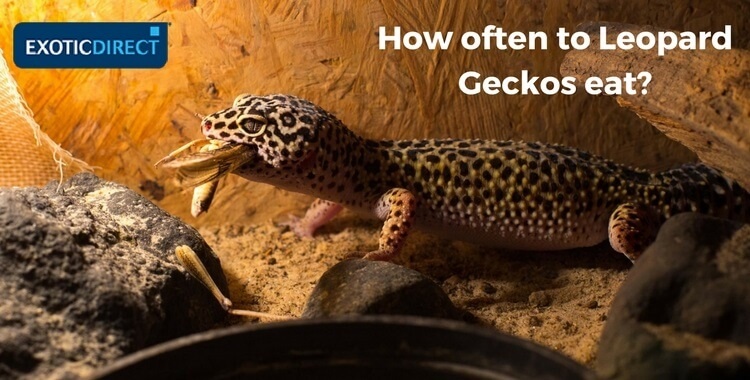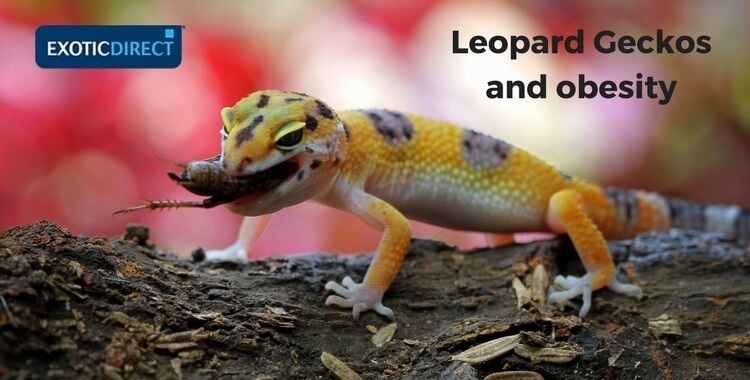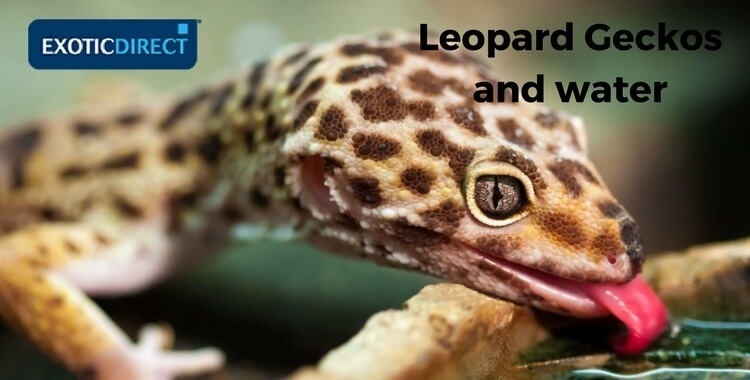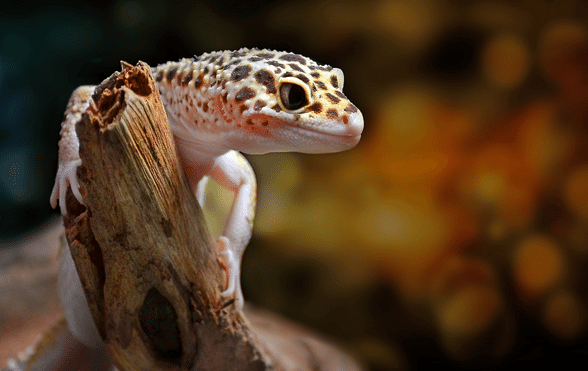Leopard Geckos are small and adorable and are among the easiest reptiles to care for. With the right food (and environment) you can’t go far wrong. Find out what you should be feeding your gecko in our food advice article.
Is your Leopard Gecko insured? Get a quote for £1,000 of vet fees, death and theft cover. Vet fee cover only also available | We’ve been insuring exotic pets since 1996 | Check out our customer reviews on Feefo.
While Leopard Gecko’s have big appetites and will eat pretty much any insect that wriggles in front of them, over-feeding them, or giving them the wrong type of food, can have very serious health consequences.
Keep reading for advice on how to provide the best diet for your Leopard Gecko.
- What do Leopard Geckos eat?
- What size food should I feed my Leopard Gecko?
- How often do Leopard Geckos eat?
- How much do Leopard Geckos eat?
- Can Leopard Geckos eat fruit and vegetables?
- What food is toxic to Leopard Geckos?
- My Leopard Gecko is not eating
- Gut loading insects
- Dusting Leopard Gecko food with vitamins and minerals
Insure your Leopard Gecko for £1,000 of vet fees. Death and theft cover also available.
Leopard Gecko food – what do Leopard Geckos eat?
The best insects to feed your Leopard Gecko are crickets and mealworms. However, you can also feed him waxworms, butterworms, silkworms, tomato hornworms, beetles, sow bugs and cockroaches.
Waxworms and superworms should be fed as a treat as they’re high in fat. Too many may lead to obesity in your gecko, so providing these around once a week should be enough.
Butterworms should also be kept as a treat, as they are fatty, contain bad calcium and some geckos have been known to get addicted to them and refuse all other food.
You can buy live food for your Leopard Gecko from Northampton Reptile Centre.
Read our article about setting up your Leopard Gecko’s vivarium
All food should be live, don’t ever feed dead or dried insects, and you shouldn’t feed him any fruit or veg.
Our vet fee only policy will cover £1,000 of vet fees for accidental injury or illness. Find out more about leopard gecko insurance.
Alternatively you can call us on 0345 982 5505.
What size food should I feed my Leopard Gecko?
- Baby Geckos: You should feed your baby gecko crickets that are around 3/8 inches in size.
- Juvenile Geckos: You should feed your juvenile gecko crickets that are around 1/4 inch in size.
- Adult geckos: You should feed your adult gecko small adult to adult size crickets.
As a rule, you shouldn’t feed your gecko insects bigger than the space between his eyes.
You can buy crickets from Northampton Reptile Centre.
How often do Leopard Geckos eat?
- Leopard Geckos younger than one year should be fed every day.
- Healthy adult geckos should be fed every other day.
- Sickly geckos should be fed once a day until they regain their strength.
- Food should be given late in the day or early in the evening, as that is the time Leopard Geckos are likely to start hunting in the wild.
- If your gecko is a problem eater, feed it normally, but leave a dish with worms in its tank in case it wants to eat later.
 Baby geckos should eat everyday, adult geckos every other day.
Baby geckos should eat everyday, adult geckos every other day.
How much do Leopard Geckos eat?
Whether he’s a baby, juvenile or adult Leopard Gecko, he should be fed two insects for every inch of body length.
Don’t forget that adult geckos should only be fed every other day.
Can Leopard Geckos eat fruit and vegetables?
Leopard Geckos are insectivores and cannot eat fruit or vegetables. A Leopard Gecko’s body can only digest meat, such as insects.
The reason they can’t eat fruit or vegetables is because their bodies aren’t designed to manage or digest fruit and vegetables.
They don’t possess a functioning Cecum, which is the part of the body that would digest Cellulose, the substance found in fruit and vegetables.
In addition, they have a shorter digestive tract, that is alkaline, where as a herbivore has a much longer and acidic digestive tract.
They also have a skull and jaw that has evolved to eat meat, being smaller and less robust than a herbivores.
Some research has revealed that Leopard Gecko’s can eat fruit and vegetables, however, as they cannot digest it, it’s unlikely that it’ll do them any good.
If your Leopard Gecko does eat fruit and vegetables, it’s likely that they’re doing it because the food is ‘there’ and not because it’s a natural thing for them to do.
We would recommend sticking to a diet of insects, a food they can naturally digest.
You can buy insects and worms, from the Northampton Reptile Centre, or via other reptile outlets.
Source: Leopard Gecko Talk, via YouTube.
 Your Leopard Gecko’s tummy should mostly be flat, unless he’s just eaten
Your Leopard Gecko’s tummy should mostly be flat, unless he’s just eaten
Leopard Geckos and obesity
It’s your responsibility to avoid over feeding your Gecko, to help prevent obesity.
In the Leopard Geckos natural habitat (the dry regions of South-eastern Asia), the availability of food varies drastically according to conditions.
For this reason, Leopard Geckos have developed a habit of effectively processing and storing food, which is helpful in the desert, but may cause over-eating and obesity in captivity.
As they carry their fat in their tales, it is not always obvious they are gaining too much weight, but this can still have health consequences.
As a rule, a gecko’s tail must always be wider than its body and its stomach should be mostly flat (except for right after feeding).
Over feeding your Leopard Gecko can cause it to regurgitate its food and may cause lethargy. If you notice any of these issues with your Leopard Gecko, you should cut back on the amount of food you feed it and make sure not to feed it fatty insects (like Waxworms and Butterworms).
What food is toxic to Leopard Geckos?
-
- Bugs that light up are toxic to Leopard Geckos: The most harmful insects are bugs that light up (like Lightning Bugs and Fireflies).These bugs contain chemicals which are extremely toxic to geckos and should never be used as a food source.
- Wild caught insects can be toxic to Leopard Geckos: Opinions are split on whether you should feed your geckos insects you’ve caught yourself.Some websites say that these can be a good (and cost effective) source of nutrition, while others like Thebeardeddragon.org, say you should never feed wild caught insects to your gecko, as these may contain parasites or have traces of pesticide that can be toxic to your Leopard Gecko.
If you do choose to feed your gecko insects you’ve caught yourself, make sure you have an in-depth knowledge on the kind of insects which are toxic to geckos and be aware of pesticide contamination (so, preferably stick to your own garden).
Keep these as a treat to stop your gecko becoming addicted to them and refusing to eat shop-bought food.
Policies can include vet fee cover, mortality and theft. Getting a quote is quick and easy. Read more about leopard gecko insurance.
Alternatively you can call us on 0345 982 5505.
 Leopard Geckos should drink clean, fresh water
Leopard Geckos should drink clean, fresh water
What should a Leopard Gecko drink?
Your Leopard Gecko must drink clean, fresh water, that should be available in your gecko’s tank at all times.
Make sure the dish is shallow, so that your gecko can drink from it easily, and there is no chance of it drowning if it managed to climb into it.
As the substrate in the cage should be kept dry, the dish should be stable to avoid spillage.
My Leopard Gecko is not eating
-
- Your Leopard Gecko may not be eating because its tank is too cold: The first thing to check here is the temperature in your gecko’s tank. Leopard Geckos are reptiles, and as such are dependent on external ways to help regulate their body’s temperature.Your Leopard Gecko needs heat to digest its food and so, if its tank is too cold, it will go off its food. If the problem persists, the cold may also affect your gecko’s immune system.
-
- Your Leopard Gecko may not be eating because its stressed: Another potential reason for your Leopard Gecko refusing to eat is stress.Changes in its environment may lead to this, which is why geckos sometimes take time to start eating when you first bring them home.Setting your gecko’s tank with plenty of hides for it to retreat to will help alleviate this issue.
- Your Leopard Gecko may not be eating because it’s dehydrated: Another important thing to note is that your Leopard Gecko has enough water in its tank, as dehydration may also cause it to stop eating.
If you’ve taken all the steps mentioned above and your Leopard Gecko is still refusing to eat, you should seek the advice of a vet, as it may be indicative of a serious health issue.
Check out our article on the loss of appetite in reptiles for more information on why your gecko might not be eating.
Gut loading insects for your Leopard Gecko
The best way to insure your Leopard Gecko gets all the vitamins and minerals it needs is by gut loading the insects you feed him.
Gut loading means feeding the insects nutritious food before you give them to your Leopard Gecko to eat. It is recommended to gut load the insects 12 hours before feeding them to your gecko.
-
- Crickets can eat a variety of fruit and vegetables in order to provide your Leopard Gecko with extra nutritional value (but avoid acidic fruit and veg, as well as spinach and broccoli).You can buy cricket feed and gel balls that act as a water source from the Northampton Reptile Centre.Make sure to change the crickets’ food regularly, to avoid the build-up of mould.
- Mealworms like to eat carrots. These should be given to them 24 hours before you feed them to your gecko. Cricket gut loading food can be placed with the carrots to give the mealworms extra nutrition.If you leave mealworms in your gecko’s tank for it to eat whenever it wants, you might consider leaving some food for the mealworms as well, so they are gut loaded for whenever your Leopard Gecko chooses to eat them.
Dusting Leopard Gecko food with vitamins and minerals
You can ensure your Leopard Gecko receives most of the vitamins and minerals he needs by dusting the insects before you feed them to your gecko.
Calcium is particularly important for hatchling and juvenile geckos and for females during breeding season, if they are to produce eggs.
You can dust your insects putting them in a bag containing the powder, ensuring their bodies are covered.
You should feed the insects to your gecko straight away to avoid the powder being licked or rubbed off.
You can dust your Leopard Gecko’s food with a vitamin, mineral and amino acid complex such as Zoo Med Reptivite with D3 available from the Northampton Reptile Centre.
Do Leopard Geckos eat their own?…
-
- Do Leopard Geckos eat their own skin? Yes. After shedding, Leopard Geckos eat their shed skin. They do this for two reasons – so that no one would know they were there (to avoid predators in the wild), and because the shed skin contains protein and vitamins helpful for growth, which they cannot get in any other way.
-
- Do Leopard Geckos eat their own eggs? Sometimes they do, yes. Female Leopard Geckos sometimes lay eggs which are infertile (so, not created through contact with a male and therefore no baby is inside them). In this case, they may eat them.Opinions on whether Leopard Geckos will eat fertile eggs are split, with some saying they might, if they feel threatened or lack calcium, and some saying they would not do so under any circumstances.
This is the same on whether Leopard Geckos will eat their young. For precaution, If you have more than one Leopard Gecko, it is best to keep the eggs in a separate tank with their mother, and separate adult and hatchling geckos.
- Do Leopard Geckos eat their own poop? The general opinion here is that Leopard Geckos would not eat their own poop. They may sometimes try to bury it though, so make sure you check your Leo’s tank carefully.
Sources: The Gecko Spot; The Bearded Dragon.org; The Reptile Blog and Leopard Gecko Guy.com
Find out more about leopard gecko insurance, or…
Alternatively you can call us on 0345 982 5505
Own a cat or dog? Get pet insurance that covers up to £12,000 for dogs and £9,000 for cats in vet fees every year, including dental for illness and accidents with British Pet Insurance.

